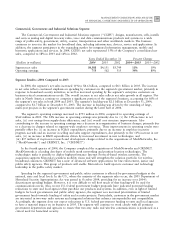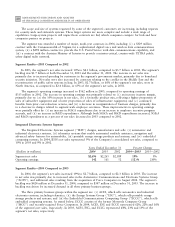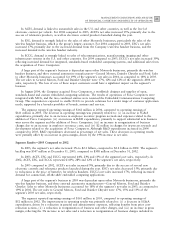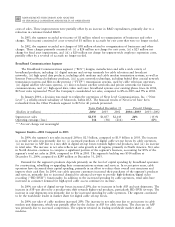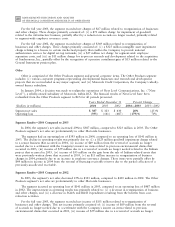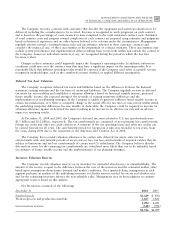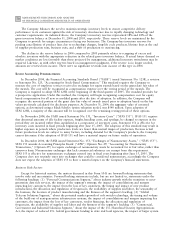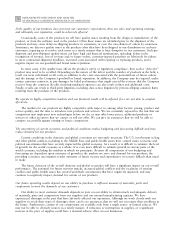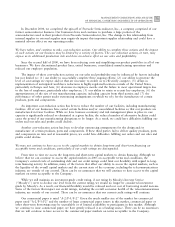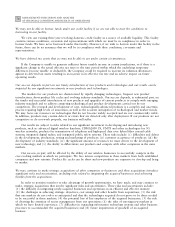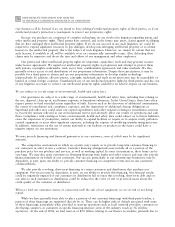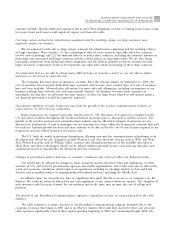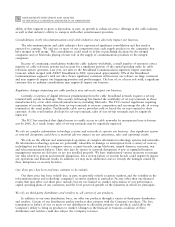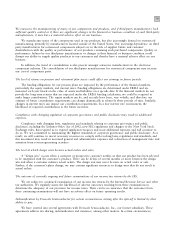Motorola 2004 Annual Report Download - page 77
Download and view the complete annual report
Please find page 77 of the 2004 Motorola annual report below. You can navigate through the pages in the report by either clicking on the pages listed below, or by using the keyword search tool below to find specific information within the annual report.
69
MANAGEMENT'S DISCUSSION AND ANALYSIS
OF FINANCIAL CONDITION AND RESULTS OF OPERATIONS
The Company executes contracts with customers that describe the equipment and system speciÑcations to be
delivered, including the consideration to be received. Revenue is recognized as work progresses on each contract
and is based on the percentage of costs incurred to date compared to the total estimated contract costs. Estimates
of total contract costs and progress toward completion of each contract are prepared using estimates and judgments
based on historical experience and on other factors believed to be relevant under the circumstances. Management
regularly assesses normal, recurring business risks and uncertainties inherent in these customer contracts and
considers the impact, if any, of these uncertainties in the preparation of contract estimates. These uncertainties may
include system performance and implementation delays resulting from events both within and outside the control of
the Company. Losses on individual contracts, if any, are recognized during the period in which the loss Ñrst
becomes evident.
Changes in these estimates could negatively impact the Company's operating results. In addition, unforeseen
conditions could arise over the contract term that may have a signiÑcant impact on the operating results. It is
reasonably likely that diÅerent operating results would be reported if the Company used other acceptable revenue
recognition methodologies, such as the completed-contract method, or applied diÅerent assumptions.
Deferred Tax Asset Valuation
The Company recognizes deferred tax assets and liabilities based on the diÅerences between the Ñnancial
statement carrying amounts and the tax bases of assets and liabilities. The Company regularly reviews its deferred
tax assets for recoverability and establishes a valuation allowance based on historical taxable income, projected
future taxable income, the expected timing of the reversals of existing temporary diÅerences and the
implementation of tax-planning strategies. If the Company is unable to generate suÇcient future taxable income in
certain tax jurisdictions, or if there is a material change in the actual eÅective tax rates or time period within which
the underlying temporary diÅerences become taxable or deductible, the Company could be required to increase its
valuation allowance against its deferred tax assets resulting in an increase in its eÅective tax rate and an adverse
impact on operating results.
At December 31, 2004 and 2003, the Company's deferred tax assets related to U.S. tax carryforwards were
$1.5 billion and $1.2 billion, respectively. The tax carryforwards are comprised of net operating loss carryforwards,
foreign tax credit and other tax credit carryovers. A majority of the net operating losses and other tax credits can
be carried forward for 20 years. The carryforward period for foreign tax credits was extended to ten years, from
Ñve years, during 2004 due to the enactment of the American Jobs Creation Act of 2004.
The Company has recorded valuation allowances for certain state deferred tax assets, state tax loss
carryforwards with carryforward periods of seven years or less, tax loss carryforwards of acquired entities that are
subject to limitations and tax loss carryforwards of certain non-U.S. subsidiaries. The Company believes that the
deferred tax assets for the remaining tax carryforwards are considered more likely than not to be realizable based
on estimates of future taxable income and the implementation of tax planning strategies.
Inventory Valuation Reserves
The Company records valuation reserves on its inventory for estimated obsolescence or unmarketability. The
amount of the reserve is equal to the diÅerence between the cost of the inventory and the estimated market value
based upon assumptions about future demand and market conditions. On a quarterly basis, management in each
segment performs an analysis of the underlying inventory to identify reserves needed for excess and obsolescence
and for the remaining inventory assesses the net realizable value. Management uses its best judgment to estimate
appropriate reserves based on this analysis.
Net Inventories consisted of the following:
December 31
2004
2003
Finished goods $1,429 $ 830
Work-in-process and production materials 1,665 1,861
3,094 2,691
Less inventory reserves (548) (592)
$2,546 $2,099


